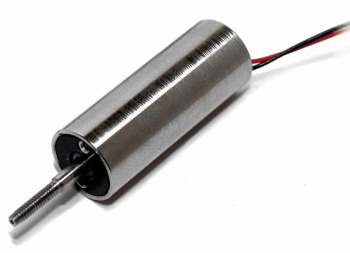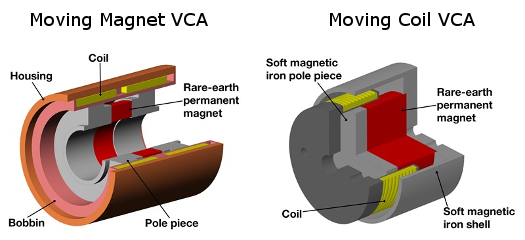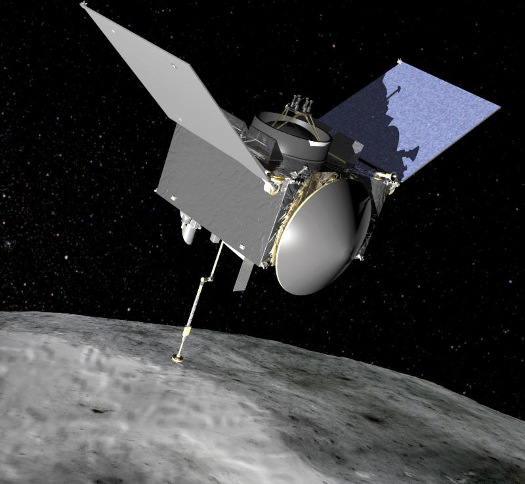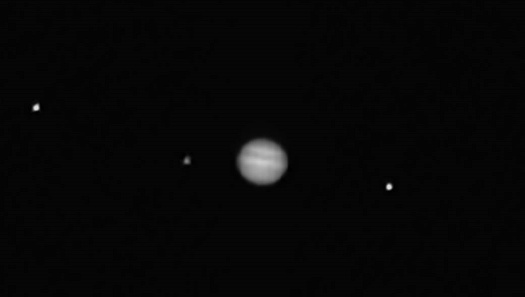 |
| August 08, 2017 | Volume 13 Issue 30 |
Designfax weekly eMagazine
Archives
Partners
Manufacturing Center
Product Spotlight
Modern Applications News
Metalworking Ideas For
Today's Job Shops
Tooling and Production
Strategies for large
metalworking plants
Mission Update: Specialized voice coil actuator onboard NASA asteroid-sampling spacecraft

BEI Kimco moving magnet VCA for the OSIRIS-Rex mission.
A customized moving magnet voice coil actuator (VCA) from BEI Kimco, a brand of Sensata Technologies, is a part of NASA's first asteroid sampling mission that could revolutionize our understanding of the early solar system.
Voice coil actuators (VCAs) are direct-drive, limited-motion devices that use a permanent magnet field and coil winding (conductor) to produce a force that is proportional to the current applied to the coil. These non-commutated electromagnet devices are used in linear and rotary motion applications that require linear force or torque output, and high acceleration or high-frequency oscillation.
BEI Kimco designed the special VCA to meet the harsh requirements for a spectrometer moving-mirror application on the Origins-Spectral Interpretation Resource Identification Security Regolith Explorer (OSIRIS-REx) spacecraft. The OSIRIS-REx launched Sept. 8, 2016, from Cape Canaveral Air Force Station for its mission to rendezvous with the asteroid named Bennu in 2018 and return samples to Earth in 2023.
Most linear voice coil actuators use a "moving coil" design, meaning that the coil itself moves while the magnets remain stationary within the assembly. However, there are times when using a "moving magnet" design, which is the inverse of a moving coil, would be beneficial. Some of the advantages include increased heat dissipation and an absence of moving lead wires.

The moving magnet voice coil actuator (left) keeps the coil fixed so that the heat generated by the coil assembly can be easily managed compared to the moving coil-type actuator (right).
For this space mission, a customized BEI Kimco moving magnet VCA was attached to, and will position, the moving mirror assembly of the OSIRIS-REx Thermal Emission Spectrometer (OTES). As the spacecraft approaches Bennu, the spectrometer scans the surface so that the material can be analyzed for different parameters.

OSIRIS-REx will return samples from the Bennu asteroid to Earth.
Bennu orbits the sun between Venus and Mars. It crosses Earth's orbit sometimes and comes close to us every six years. In 2135, the asteroid is predicted to come so close to Earth that it will be between Earth and our moon. That encounter may well change the orbit of the asteroid, making it more difficult to predict how close it will come in the future.
OSIRIS-REx will spend two years surveying the asteroid, which is a boulder about as tall as the Empire State Building, in unprecedented detail. Then, in a robotic first, the spacecraft will reach out its 11-ft mechanical arm and take a sample from the asteroid. Though the sample will be small (only a couple of pounds at most), it should provide a time capsule of sorts, recording our solar system's creation. With the sample stored safely, the spacecraft will speed away from the asteroid on a path back to Earth in March 2021, if all goes according to plan. The samples are scheduled to arrive back at our planet in September 2023, when the capsule that contains them is ejected and sent to the Earth's surface.
The BEI Kimco VCA was uniquely manufactured to custom requirements for high reliability and fail-safe operation. Redundant technology, low outgassing, and high precision for exact motion control positioning were all key requirements to the actuator design. It was also critical to stay within the specific size, weight, and power limits. This was achieved in a housing measuring approximately 2 in. in diameter by 3 in. long.
To meet the requirements for near-zero emissions, BEI Kimco developed the actuator minimizing the use of adhesives or inks and using only approved materials. This design primarily uses mechanical assembly methods within a clean manufacturing process, thereby eliminating substances that could cause outgassing. High-energy Neodymium Iron Boron (NeFeB) magnets were incorporated to provide superior operating efficiencies.
Since the mission launch in 2016, the OSIRIS-REx spacecraft has been busy doing other types of "fieldwork" during its two-year journey to Bennu -- and before it has to put that BEI Kimco VCA to work.
During an almost two-week search in February this year, the mission team activated the spacecraft's MapCam imager and scanned part of the surrounding space for elusive Earth-Trojan asteroids -- objects that scientists believe may exist in one of the stable regions that co-orbit the sun with Earth. It flew through the center of Earth's fourth Lagrangian area -- a stable region 60 degrees in front of Earth in its orbit where scientists believe asteroids may be trapped. Though no new asteroids were discovered in the region that was scanned, the spacecraft's cameras MapCam and PolyCam successfully acquired and imaged Jupiter and several of its moons, as well as Main Belt asteroids.

The PolyCam imager captured this image of Jupiter (center) and three of its moons, Callisto (left), Io, and Ganymede. The image, which shows the bands of Jupiter, was taken on Feb. 12, when the spacecraft was 76 million miles (122 million km) from Earth and 418 million miles (673 million km) from Jupiter. PolyCam is OSIRIS-REx's longest range camera and will initially capture images of the asteroid Bennu from a distance of 2 million km -- so scientists should clearly see their final target coming from far away.
"The Earth-Trojan Asteroid Search was a significant success for the OSIRIS-REx mission," said OSIRIS-REx Principal Investigator Dante Lauretta of the University of Arizona, Tucson. "In this first practical exercise of the mission's science operations, the mission team learned so much about this spacecraft's capabilities and flight operations that we are now ahead of the game for when we get to Bennu."
The Earth Trojan survey was designed primarily as an exercise for the mission team to rehearse the hazard search the spacecraft will perform as it approaches its target asteroid Bennu. This search will allow the mission team to avoid any natural satellites that may exist around the asteroid as the spacecraft prepares to collect a sample to return to Earth in 2023 for scientific study.
The spacecraft's MapCam imager, in particular, performed much better than expected during the exercise. Based on the camera's design specifications, the team anticipated detecting four Main Belt asteroids. In practice, however, the camera was able to detect moving asteroids two magnitudes fainter than expected and imaged a total of 17 Main Belt asteroids. This indicates that the mission will be able to detect possible hazards around Bennu earlier and from a much greater distance than originally planned, further reducing mission risk.
For more information on OSIRIS-REx, visit: www.nasa.gov/osiris-rex.
For information on the BEI Kimco actuator, contact BEI Kimco at sales@beikimco.com or www.beikimco.com.
Sources: NASA Goddard Space Flight Center, BEI Kimco
Published August 2017
Rate this article
View our terms of use and privacy policy
